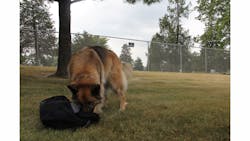A German Shepherd cruises past a string of high school lockers. A bloodhound leads the pack in a search and rescue. A friendly yet professional Beagle sniffs parcels in airport baggage. Some dog breeds are trained and conditioned to pick up traces of accelerants at the scene of an arson or detect the odor of decomposing bodies.
In many law enforcement agencies in the United States, police K-9s are bona fide police officers with professional training and an inherent talent for detecting organic and inorganic substances. Even today, as detection technology devices are being made more accurate and easy-to-use than ever, could such devices every really replace these savvy animals that specialize in high-stakes smelling?
What makes dogs such great detectors?
We humans navigate this big, complex world of ours mostly through sight. We recognize slight differences in a type font, for example, or notice specks of dust on top of the coffee table. We see and internalize vast amounts of information with just our eyes as we stand at the curb of a busy city intersection, waiting for the ‘walk’ signal to appear. But dogs, since the very beginning, have navigated the world with their nose.
Paul Waggoner with Canine Detection Research Institute (CDRI) at Auburn University finds it fascinating that dogs continue to teach humans about their capabilities and behavior, in terms of the work humans want them to do.
“They have an extraordinary acuity to not only detect, but to discriminate between different chemicals...just like people come very well prepared to make amazing visual discriminations,” says Waggoner. Dogs can pick out a needle in a haystack, so to speak, in an odor-noisy environment. It is this chemical interaction with the world that has continued to develop since the time when the smallest organisms evolved, what biologists would call an ‘extraordinarily preserved sense.’
Waggoner researches canine behavior and recalls seeing a rapid advance and interest in developing new detection technologies to emulate a dog’s nose all the way back to the mid-90s.
“It started out where instrumental folks would get up and say, ‘You know, we’re going to be able to replace this pesky black box of a dog that we don’t really understand in just a few years.’ And then, if you go ahead another decade the comments are more like, ‘We’re getting closer and we’re making more advances, but the dog’s probably going to be around and with us doing detection for many years to come.’”He says most scientists in the business agree it is essential to research what dogs can do in order to better strategize detection instrumentation. They agree, too, it’s doubtful such technology will ever really mimic a dog’s capabilities in full.
Channeling a dog’s nose
But that doesn’t stop manufacturers from trying. And as new detectors come to market they come in many forms, from handheld devices to mobile robots.
One such item is RedXDefense’s XCAT handheld detection system for narcotics, explosives and gunshot residue. In lieu of a bark and a tail wag, XCAT gives a red light/green light results indication. Assistant Chief Gerald Clinger with the Indianapolis Airport Police weighed in, saying the device was useful because its portability allowed his team to check unattended bags and parcels further from the terminal, and says he will routinely use it when K-9s are not available. Results show up quickly (in less than one minute) and accurately. “Everybody understands the concept. I mean it only works one way...We call it ‘cop-proof’. If a cop couldn’t break it and could figure it out, it was going to work for us,” says Clinger.
Another product designed for “sniffing” contraband, the Mini Z from American Science and Engineering Inc. is a handheld Z Backscatter imaging scanner for real-time detection of hidden organic threats like drugs, contraband, plastic guns and explosives. Mini Z was launched at the Police Security Expo in Atlantic City, June 2014. The technology is well-known within customs and military applications, but parlays nicely into public safety as a small, nine-pound tool that one can toss into the trunk.
With Mini Z users scan an object from any side or angle, from two to six inches away. Its low-energy, low-dose X-rays penetrate light density materials (aluminum, but not steel), thus Mini Z could essentially get much the same information a K-9 might sense, and perhaps more.
So far agencies have used it to find drugs tucked away in car tires, airbag panels, and inside seats. The imager then shows all the different objects within a scan path. “It’s not a specific identifier, like a TRACE system might be, but this will show you a ceramic knife or composite weapon or bag of drugs. It will show you odd shapes and allow you to analyze the image and determine if there’s an anomaly...something that doesn’t belong,” says Tim McCabe, vice president of marketing and tech sales at ASE. Finally the image is saved to a database with an operator ID and time-stamped, and can be further analyzed with software tools that pan/zoom/scroll and change density.
Detection instrumentation is often deployed in places where it may be too dangerous for humans or dogs. The Shasta (Calif.) Sheriff’s Office recently pooled grant resources with surrounding counties to purchase a robot through a Homeland Security grant. Sergeant Jason Barnhart, Shasta County’s Office bomb commander, talks about using the new F6A RemoteTech at a call where a resident was brewing homemade HMTD (Hexamethylene triperoxide diamine) and mercury fulminate in his residence, leading to an accidental detonation.
“It took his hand off, almost up to the elbow,” says Barnhart, speaking of the suspect. “Then he lost his sight in one eye and had injuries to his face and body...that sort of thing.” Sheriff’s deputies arrived on scene and took photographs of the area. Then the bomb team was dispatched. The first order of business was to deploy the new robot downrange to gather information. Operators could see what the robot saw, it’s movement and the video it recorded. “It gave us knowledge, confirmed what the deputies saw,” says Barnhart. “We could go over that footage and get a better assessment on the quantity of items that we were seeing...if there was any way we could go down there with one of our bomb techs and start our render safe process.”
An air monitoring device attached to the robot inside the residence “sniffed” for hazardous materials and sampled air quality.
“We ended up burning the whole house down. That’s pretty rare,” says Barnhart.
Not out of a job just yet
Despite the keen eye of a robot or the easy portability of a handheld device, detection dogs aren’t out of a job just yet. Ohio’s University Bomb Dog Initiative proves that four-legged officers are still invaluable members of the force. In an effort to improve safety at Ohio’s network of universities, state Homeland Security officials recently announced they will outfit the schools with bomb-sniffing dogs. So far K-9s have been deployed at three of the 13 state schools.
The dogs will help manage large events like Ohio State University football games that attract more than 100,000 people to the stadium every home game, or be present during visits from national and international dignitaries.
Ohio Public Safety Director John Born says explosive sniffing K-9s are a critical and very useful tool in homeland security and emergency management, and really show their value on the prevention side, which is where they want to spend some of their investment. Born was appointed public safety director about a year ago after having spent 27 years with the Ohio State Highway Patrol. He says although they are always open to new technology and doing things better, more effectively and at a lower cost, they’ve always had a strong track record with K-9s.
“The only thing we ask in return from the universities, because we are providing the dogs, equipment, as well as the dogs’ care and maintenance, is that they continue to use the dogs in partnerships in their regions,” says Born.
Paws paired with smart products
Trained K-9s and detection technology together make for a powerful investigative combination. Though dogs have the advantage in a number of ways, they’re even more effective when layered in a situation where instrumentation is used in a controlled environment, and investigators can take their time sampling and interrogating items. “At that same time you can have dogs present to do the things they’re very good at,” Waggoner says. He adds, in some ways a dog makes a better robot, as it has an innate ability to figure its way around small obstacles and think through problems.
ASE’s president Chuck Dougherty adds the federal agencies using his company’s device, Mini Z, typically use it to complement K-9 patrols. “When someone gets a dog hit on a vehicle but they’re not exactly sure where, this allows them to get a quick, visual cue to where something may be stored.”
Auburn University’s research and development team is currently working with AM Canine to cultivate “Vapor Wake detection K-9s”—dogs scientifically bred, selected and developed to detect traces of explosives in the air.
Waggoner says they are getting close to instrumenting dogs with the capability to search areas without a handler; the handler may be far back, controlling where a dog searches for explosives with computer algorithms and GPS navigation. “Dogs are much more mobile and capable of getting around areas than people are, and the dog is slowed down and the situation made more dangerous for a dog by having a slow-moving, non-able-to-sense-the-environment-nearly-as-well-as-a-dog person tagging along with them,” he says. “Of course, the other reason is to keep people out of harm’s way. A dog is able to protect itself better if it’s not hindered or hampered by a person who’s not nearly as fast or as good as a dog.”
A perfect science
Dogs’ sophisticated olfactory system is not only adept at finding bombs. They can also detect invasive species like snakes in the Everglades or fungi latching onto tree roots deep underground.
“Not all dogs are suitable for being used for detection dogs,” says Waggoner. “Maybe a better way to put it is, humans aren’t well-enough equipped to engineer the behavior of all dogs to do this, so we select the ones that are ready to be trained to do this work.
Sometimes science is about the accumulation of a lot of mistakes, a lot of things you think are the way they are, but they’re not. For me, dogs continue to show us how nature really works as opposed to how we assume it may.”
In that sense, dogs and humans may continue to learn from each other for many years, adventures, and technologies to come.

Sara Scullin
Sara Scullin was the Editor of Law Enforcement Technology magazine, a monthly business-to-business publication that covers technology trends and best practices for public safety managers. LET is part of SouthComm Law Enforcement Media, which also publishes Law Enforcement Product News and Officer.com. Sara had covered the law enforcement industry since March 2008.



